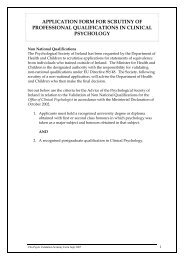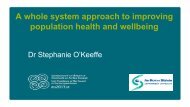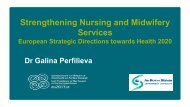All Ireland Traveller Health Study Our Geels - Department of Health ...
All Ireland Traveller Health Study Our Geels - Department of Health ...
All Ireland Traveller Health Study Our Geels - Department of Health ...
You also want an ePaper? Increase the reach of your titles
YUMPU automatically turns print PDFs into web optimized ePapers that Google loves.
<strong>All</strong> <strong>Ireland</strong> <strong>Traveller</strong> <strong>Health</strong> <strong>Study</strong><br />
Diet<br />
General Summary<br />
Just under half <strong>of</strong> respondents in ROI reported at least daily fruit or vegetable consumption (45.3%), less<br />
frequently so by men (39.4%) compared with women (49.7%), with little variation by age. In NI, 31.7%<br />
reported eating daily fruit and vegetables, again less frequently for men (27.1%) than women (35.9%)<br />
and again with minimal age variation.<br />
Four in 10 <strong>Traveller</strong> respondents in ROI (40.3%) and 31.3% in NI reported eating fried food less than once<br />
per week, with just 11.8% in ROI and 12.9% in NI reporting daily consumption. Men were more likely to<br />
consume fried food frequently than women. This pattern was also inversely age related: 17.1% in ROI<br />
and 15.1% in NI <strong>of</strong> those under-30 years consumed fried food daily, compared with 1.1% <strong>of</strong> the oldest<br />
respondents<br />
In ROI butter was the most popular spread (56.2%) and was consumed at least most days by both men<br />
(56.9%) and women (55.8%). There was no strong age trend. In NI consumption was more evenly spread<br />
between butter, low fat or vegetable oil spreads. In ROI a majority <strong>of</strong> respondents either usually (11.7%)<br />
or always (38%) added salt to food at table, men more so than women, and younger respondents more<br />
than older people. In NI, 19.3% usually and 20.5% always added salt to food at table, men more so than<br />
women and with little variation by age.<br />
AITHS respondents hardly ever ate out, particularly in restaurants (62.0% in ROI and 67.5% in NI), and<br />
women ate out less frequently than men. There is a strong inverse pattern, with older respondents less<br />
likely to ever eat out, and rates <strong>of</strong> fast food and home delivery consumption were higher in the younger<br />
age group in both jurisdictions.<br />
Most respondents saw no problem with trying to eat more healthily (65.4% in ROI and 52.4% in NI),<br />
and by far the most frequently cited barrier was price (29.3% in ROI and 36.8% in NI), followed by family<br />
preferences (16.2% ROI and 20.6% NI). Patterns were similar for men and women and according to age<br />
group.<br />
Commentary<br />
Compared with data from the SLAN 2007 report suggesting that 65% <strong>of</strong> adults in all social classes<br />
reported eating at least 5 portions <strong>of</strong> fruit and vegetables per day in the general population (Harrington<br />
et al., 2008), only 45.3% <strong>of</strong> <strong>Traveller</strong>s in ROI and 31.7% <strong>of</strong> <strong>Traveller</strong>s in NI report eating daily fruit and<br />
vegetables. When viewed in the context <strong>of</strong> the comparable populations, <strong>Traveller</strong>s reported more<br />
frequent consumption <strong>of</strong> fried food (Figure 17). With respect to use <strong>of</strong> butter, low fat spread and table<br />
salt, patterns <strong>of</strong> use <strong>of</strong> <strong>Traveller</strong>s closely resemble those <strong>of</strong> the SLAN 2002 population(Figure 18), with<br />
lower consumption <strong>of</strong> those fats in the NI <strong>Traveller</strong>s.<br />
216

















